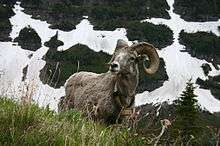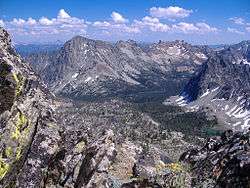Tukudeka
|
Sawtooth Range, the traditional home of the Tukudeka in central Idaho | |
| Total population | |
|---|---|
| (fewer than 5,822[1]) | |
| Regions with significant populations | |
|
| |
| Languages | |
| Shoshone, English[2] | |
| Religion | |
|
Native American Church, Sun Dance, traditional tribal religion, Christianity, Ghost Dance | |
| Related ethnic groups | |
|
other Shoshone tribes, Bannock, Northern Paiute |
The Tukudeka or Mountain Sheepeaters are a band of Eastern Shoshone, who later joined the Northern Shoshone.[3] They traditionally lived in the central Sawtooth Range of Idaho.[4] Bands were very fluid and nomadic, and they often interacted with and intermarried other bands of Shoshone. Today the Tukudeka are enrolled in the federally recognized tribe, the Shoshone-Bannock Tribes of the Fort Hall Reservation of Idaho.
Name

"Tukudeka" is spelled several ways, including Tukadüka, Tukku Tikka'a, Tukkuikka, Tukkutikka, and Tukuarika, and is translated as "Eaters of White Meat,"[5] "Eaters of Mountain Sheep," "Mountain Sheepeaters," or simply, "Sheepeaters."[4] They were named for the bighorn mountain sheep (Ovis canadensis), which they commonly hunted. They are also called Mountain Shoshone[6] or Toyahini, the mountaineers.[3]
Language
The Tukudeka speak the Shoshone language, as well as English. Shoshone is a Central Numic language in the Northern Uto-Aztecan language family.[2]
History
The Tukudeka's traditional homelands were along the Salmon River in the Sawtooth Mountains,[5] as well as southern Montana, and Yellowstone in Wyoming.[6] Europeans first entered their territory in 1824. American and British trappers hunted beavers in the 1840s. In 1860, gold was discovered, and non-native prospectors flooded the region.[5]
In the 1860s, Indian agents estimated the Tukudeka and Lemhi Shoshone, to be 1,200.[7]
In 1879 five Chinese miners were killed near Loon Creek. Despite a complete lack of evidence, the Tukudeka were blamed for the murders, and the US Cavalry attacked the tribe in what would be called the Sheepeater War. Fifty-one Tukudeka were captured and relocated to the Fort Hall Reservation.[4]
Notes
- ↑ "Shoshone-Bannock Tribes." Retrieved 24 Oct 2013.
- 1 2 "Shoshoni." Ethnologue. Retrieved 24 Oct 2013.
- 1 2 Shimkin 335
- 1 2 3 "Original Tribal and Band Names of Idaho's Native Peoples." Digital Atlas of Idaho. Retrieved 24 Oct 2013.
- 1 2 3 "History." Sawtooth National Recreation Area. Page 8. Retrieved 24 Oct 2013.
- 1 2 Murphy and Murphy 306
- ↑ Murphy and Murphy 289
References
- Murphy, Robert F. and Yolanda Murphy. "Northern Shoshone and Bannock." Warren L. D'Azevedo, vol. ed. Handbook of North American Indians, Volume 11: Great Basin. Washington, DC: Smithsonian Institution, 1986. ISBN 978-0-16-004581-3.
- Shimkin, Demitri B. "Eastern Shoshone." Warren L. d'Azevedo, volume editor. Handbook of North American Indians: Great Basin, Volume 11. Washington, DC: Smithsonian Institution, 1986: 308–335. ISBN 978-0-16-004581-3.
External links
- Shoshone-Bannock Tribes, official website
- Shoshone Language Project, Idaho State University
- "The Sheep Eaters," essay by David Dominick
